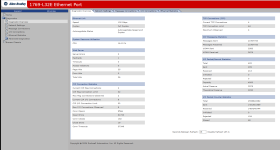MikeVT
Lifetime Supporting Member
This system is a 1769-L32E PLC/SCADA, with three 1794-AENT flex bus remote I/O stations, over Ethernet. This system has been in place for 10 (or so) years. Earlier this year (March), we had problems with blower(s) motors just dropping out, for a few seconds (<5 secs), then re-starting again. I thought I found the problem, with a Ethernet switch. I replaced the switch, and either replaced patch cables or re-terminated the ends to get all new/clean connections for the Ethernet cables. But that did not fix the problem. I 'fixed' the problem by setting the 1794-OA16/A module outputs to remain in their last state, upon comm loss.
Now another 1794-AENT and Flex I/O station (part of this same system) is showing the same output dropout problems. I would sure like to hear about troubleshooting methods, possible areas/devices to check out, and past experiences with this problem, to help me find the solution. I would like to add programming to monitor the comms status, but I'm not sure what is the best way to do that. Some advice on comms monitoring would be great too.
Thank You!
Now another 1794-AENT and Flex I/O station (part of this same system) is showing the same output dropout problems. I would sure like to hear about troubleshooting methods, possible areas/devices to check out, and past experiences with this problem, to help me find the solution. I would like to add programming to monitor the comms status, but I'm not sure what is the best way to do that. Some advice on comms monitoring would be great too.
Thank You!




